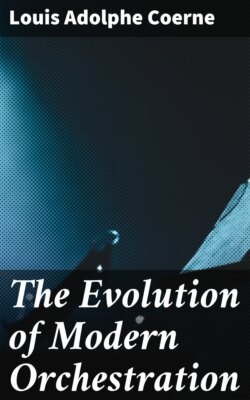Читать книгу The Evolution of Modern Orchestration - Louis Adolphe Coerne - Страница 15
I.
ОглавлениеPrehistoric origin of stringed instruments, in spite of extant relics, is a matter of conjecture. History, on the other hand, suggests various sources in various ages. Of greatest recorded antiquity are the Egyptian lute and harp, which were struck with a plectrum or plucked by the fingers. These migrated through Arabia into Spain, thence to Southern Italy, and became diffused over all Europe. The Greek lyra or kithara, having originally but four strings, was also played with a plectrum, and became the heirloom of the Romans. But to discover the origin of instruments played with a bow is a more difficult matter. A number of theories are plausible. Like all other instruments they were probably invented simultaneously by many isolated barbaric races. The bow and arrow were undoubtedly suggestive, and it is to be presumed that primitive types of the lyre family whose strings were originally plucked, were fitted to uncouth sounding-boards and played upon with a bow. The Hindoos possessed such instruments, and it is possible that their admission into Europe was concurrent with that of the lute and harp. In defence of this supposition, one might point to the dance of the women attending the Jongleurs. Now the dance is no uncertain revealer of racial characteristics. But not only the dance itself, but also certain features of the accompaniment, as well as the types of instruments peculiar to the Jongleurs bear the impress of Orientalism. As far as is known, neither the Greeks nor the Romans possessed instruments played with a bow.
From the Middle Ages on, the study of instrumental evolution is, of course, based upon authentic history. The most direct line of descent for bowed-instruments is probably from either the Celtic crwth or the Oriental rebab to the vielle or viola of the Middle Ages (Spanish vihuela, Latin fidula), of which the last representative was the gamba; and the viola da gamba was the predecessor of the violoncello. The early viols were of manifold types, there being, for instance, as many as seven viole da braccia and six viole da gambe. The violin owes its existence to a gradual metamorphosic development of the early tenor viola, during the latter part of the fifteenth and early sixteenth centuries. Skill in the manufacture of these instruments was of an advanced order in the Netherlands prior to the advent of the great Italian violin makers, whose efforts were eventually crowned by the immutable sovereignty of the Cremonese creations at the commencement of the eighteenth century. The introduction of the contrabasso was likewise of slow growth. For as late as the seventeenth and eighteenth centuries there still existed bass instruments of the lute family, such as the double-necked theorbo and the largest bass lute, the chitarrone, which were struck with a plectrum. But growing appreciation for the wonderful possibilities concealed in the infant violin proper, of technique, tone, color, delicacy, and variety of shading, reacted upon the secondary bowed-instruments, and they in turn were rapidly perfected. Hence, by a judicious selection of the superior and a suppression of the inferior types of viols were the violas and violoncellos evolved; and the theorbo and chitarrone were permanently supplanted by the double-bass, constructed on the same general principles as the violin.
Although the ideal balance of tone and expressive powers as embodied in the modern string orchestra justifies the perspicuity of this selective process in every way, it would seem to be a matter for regret that a certain species of viols, the viola d'amore, should have become practically obsolete. Its seven strings were supplemented by seven concealed under strings, designed to vibrate sympathetically. One might say that this principle has been incorporated in the modern grand pianoforte by means of the "una corda" pedal. But since Meyerbeer resuscitated the viola d'amore in "Les Huguenots" in 1836, the only living composer who has assigned to it a conspicuous rôle is, to the present writer's knowledge, Mr. C.M. Loeffler in his symphonic poem "La Mort de Tintagiles," after Maeterlinck, indeed the original score contained parts for two solo viole d'amore though one part has since been rewritten for a violin.
